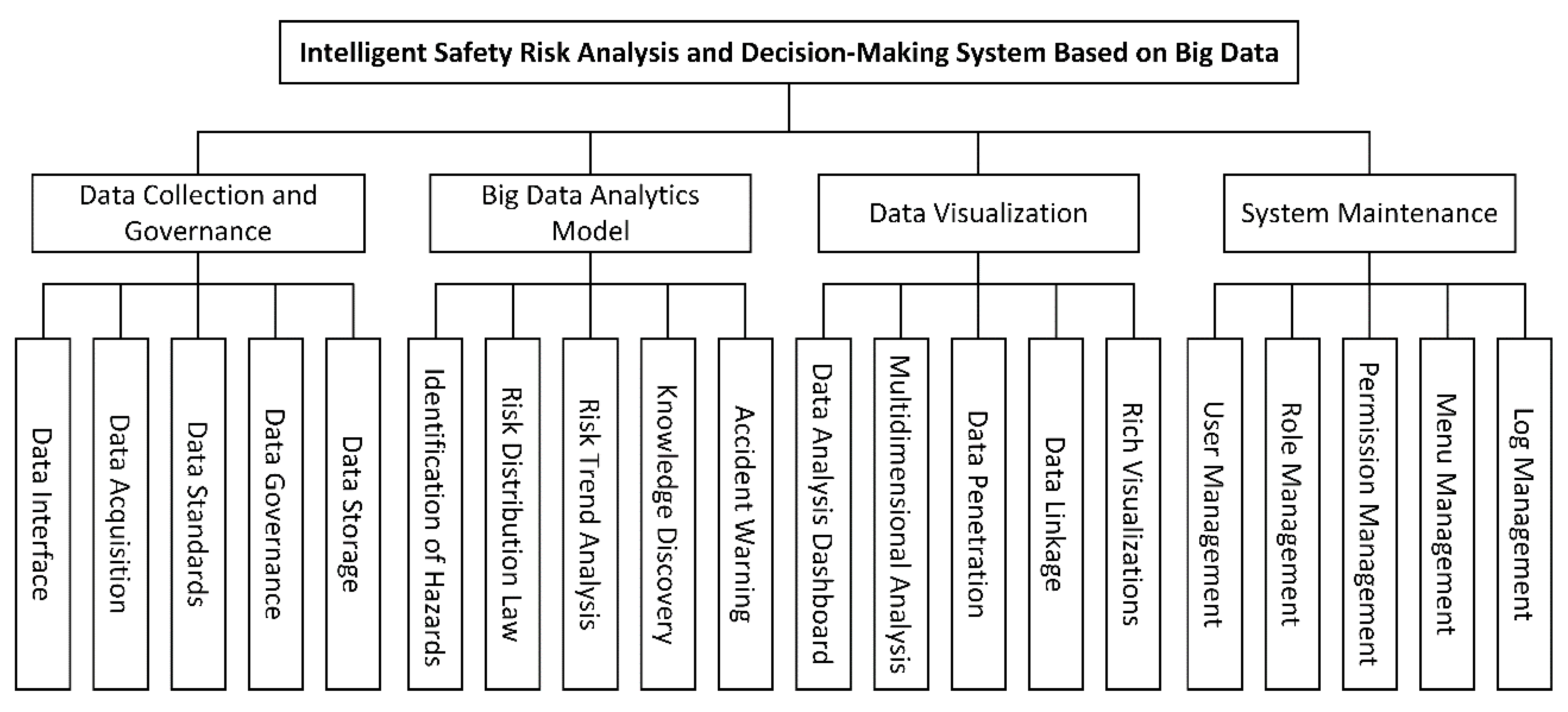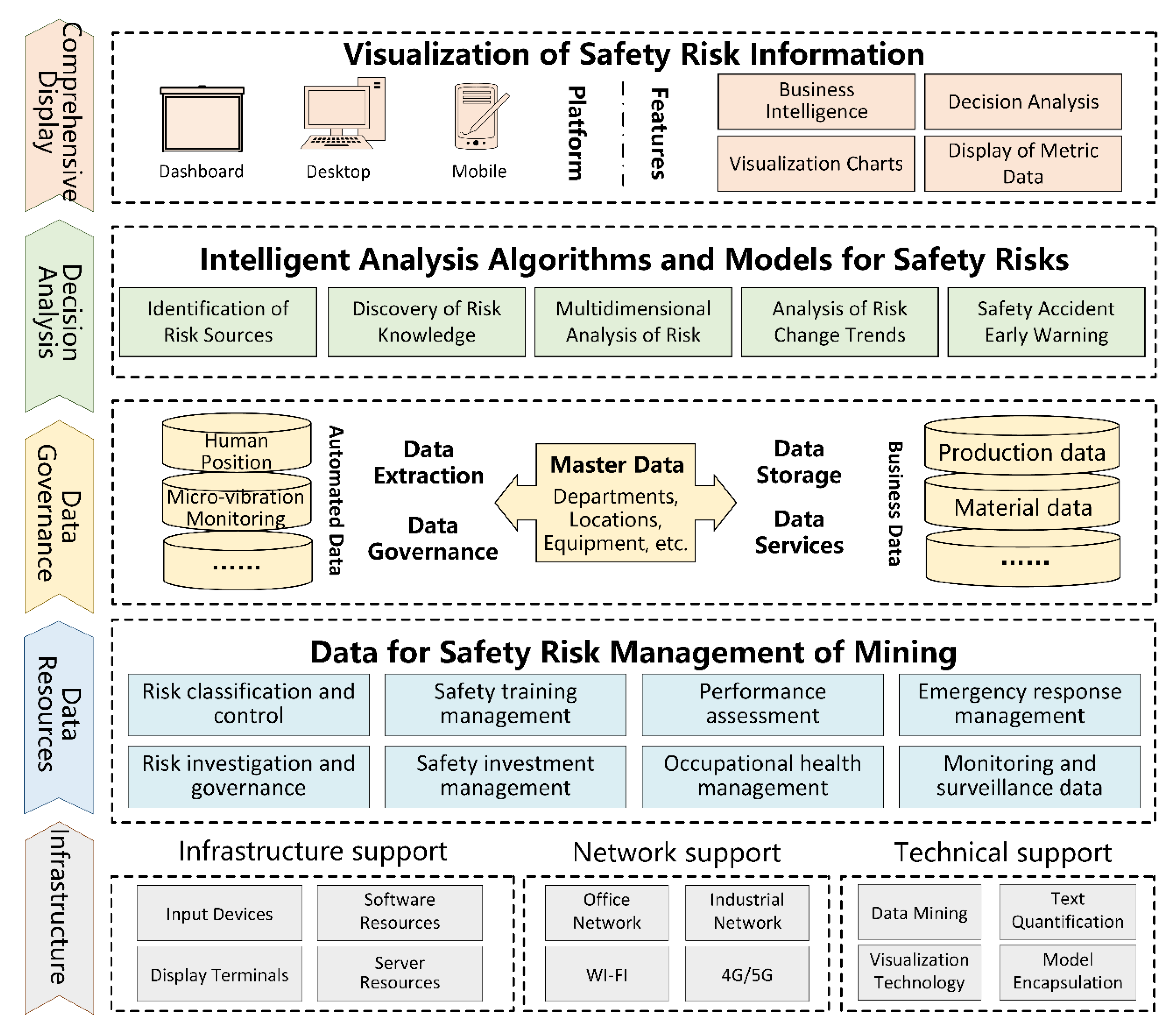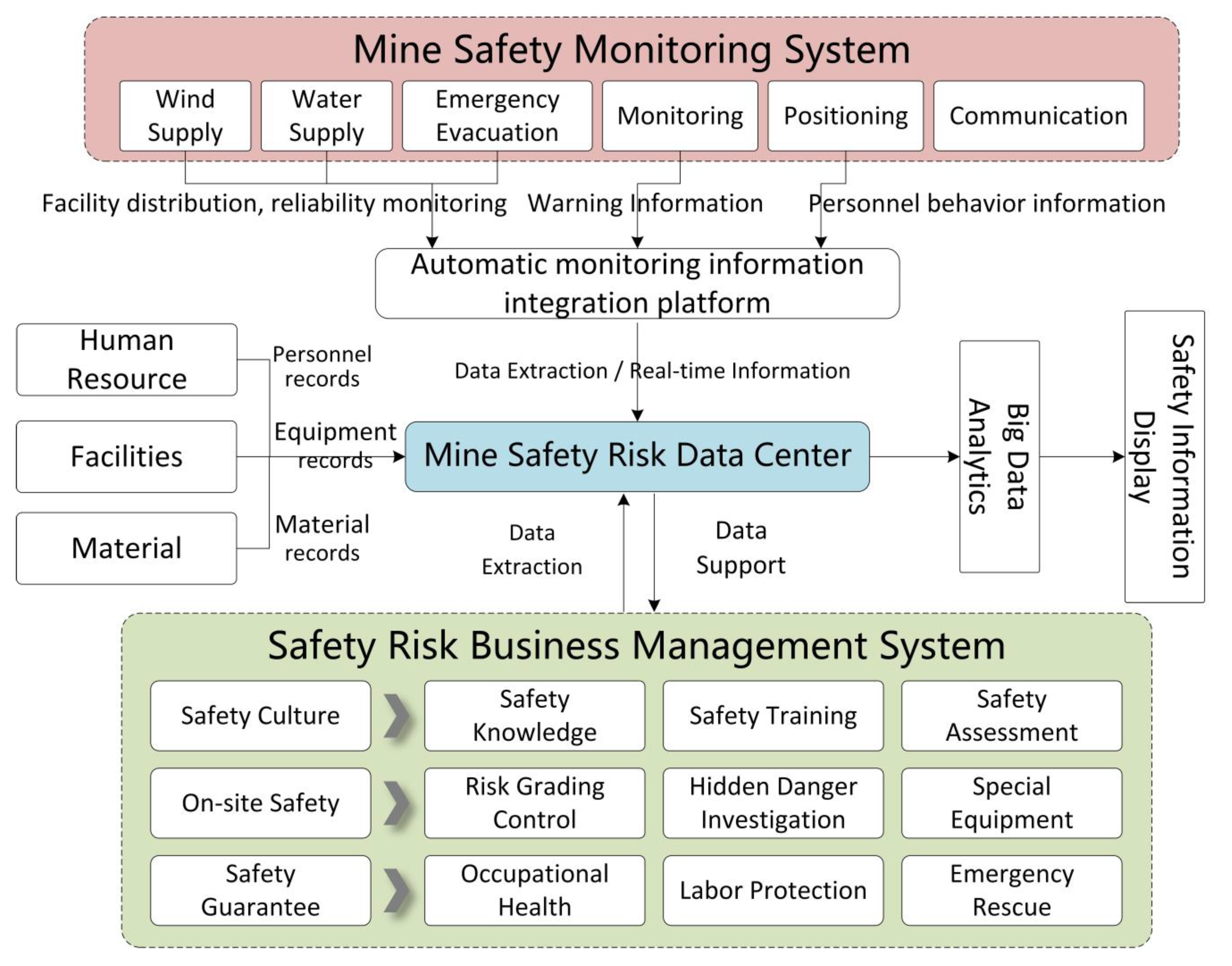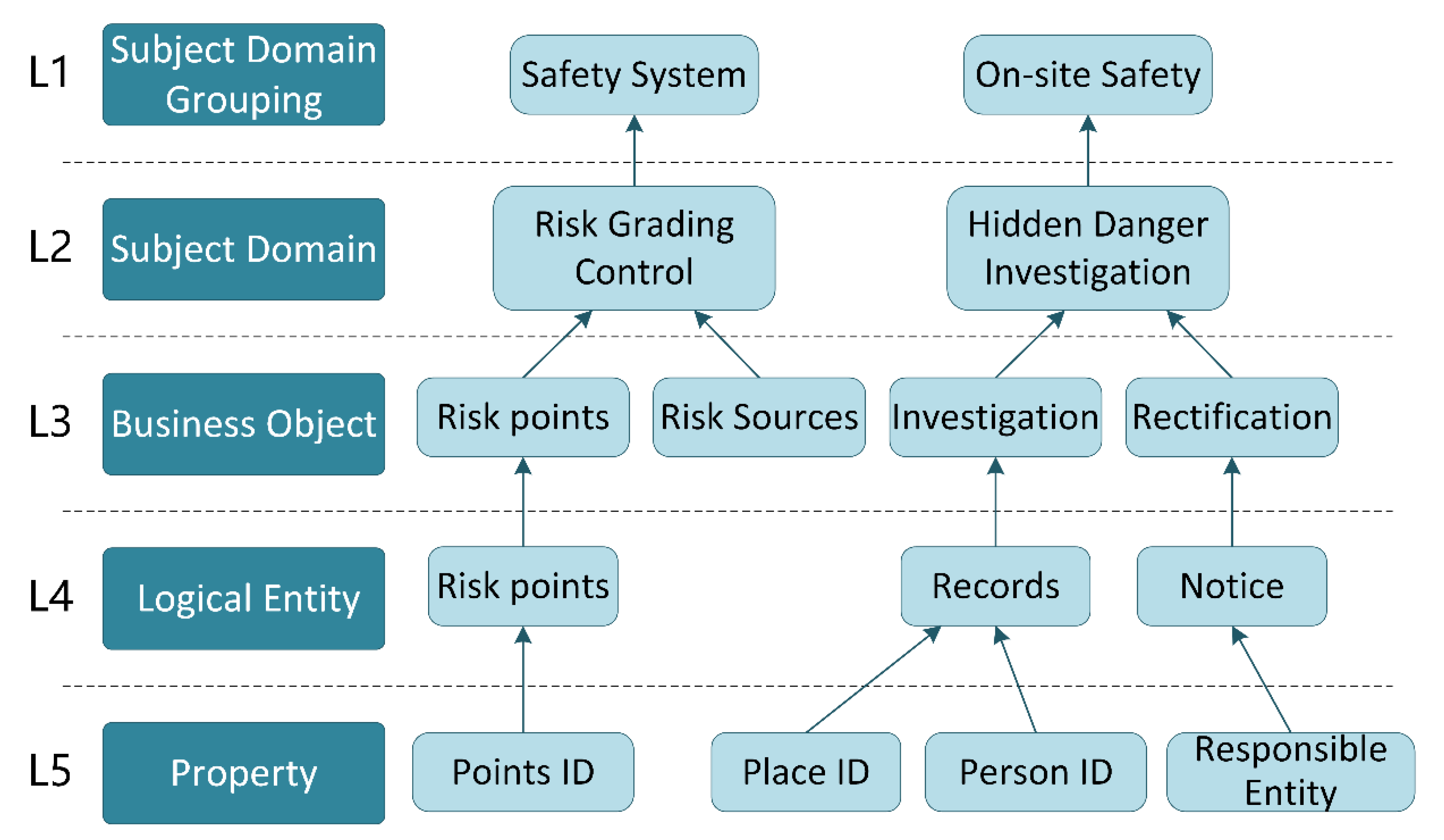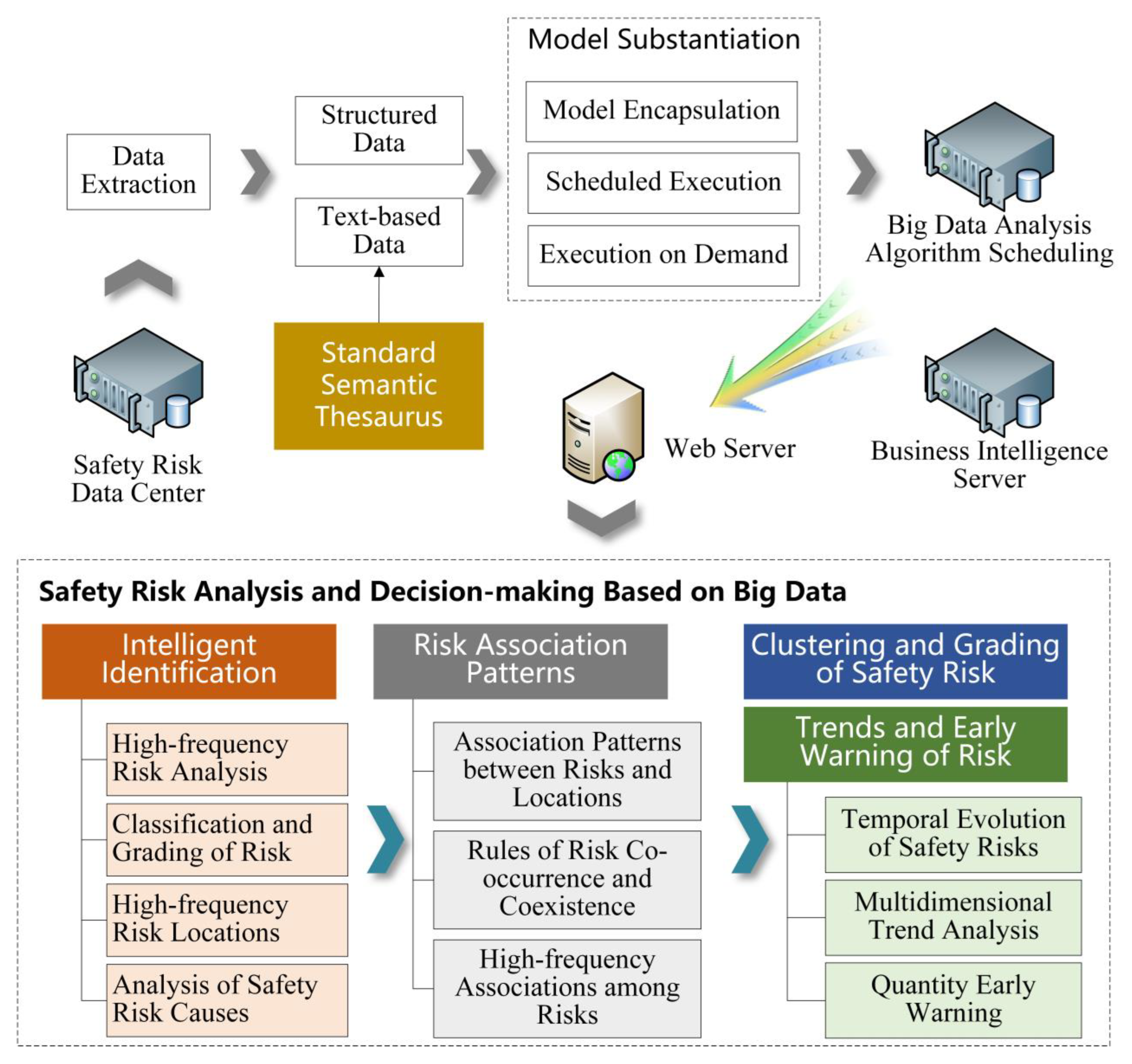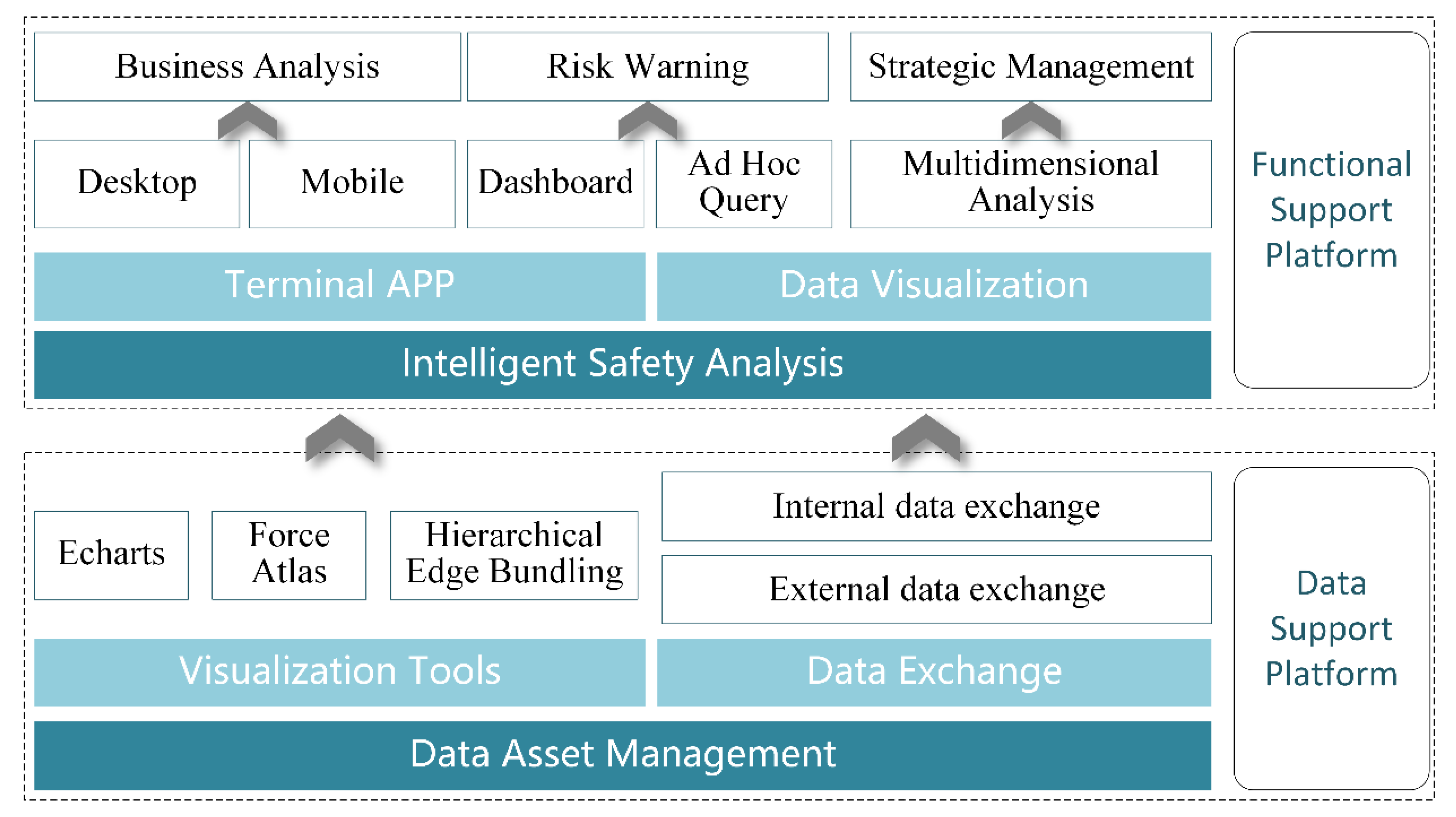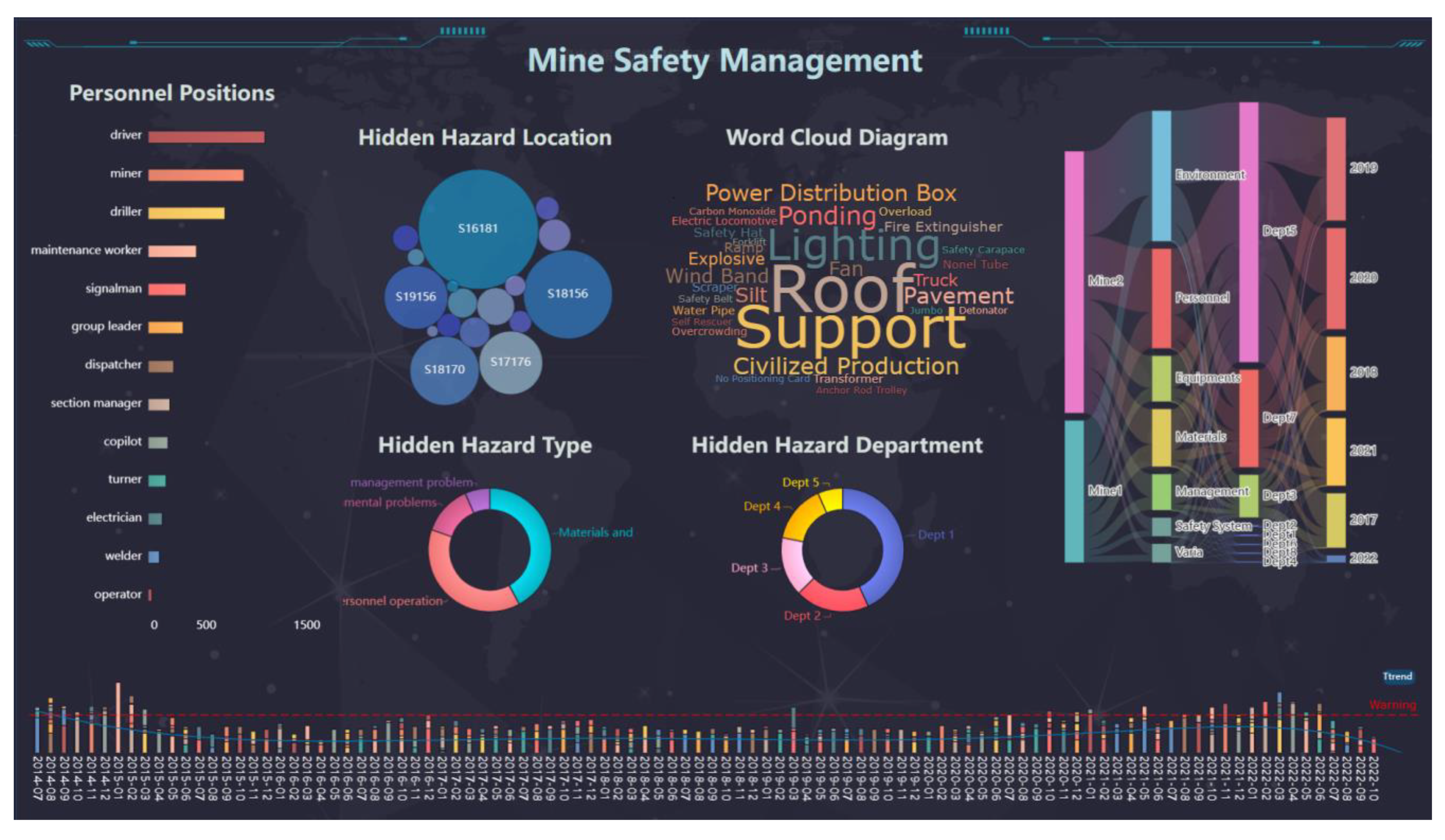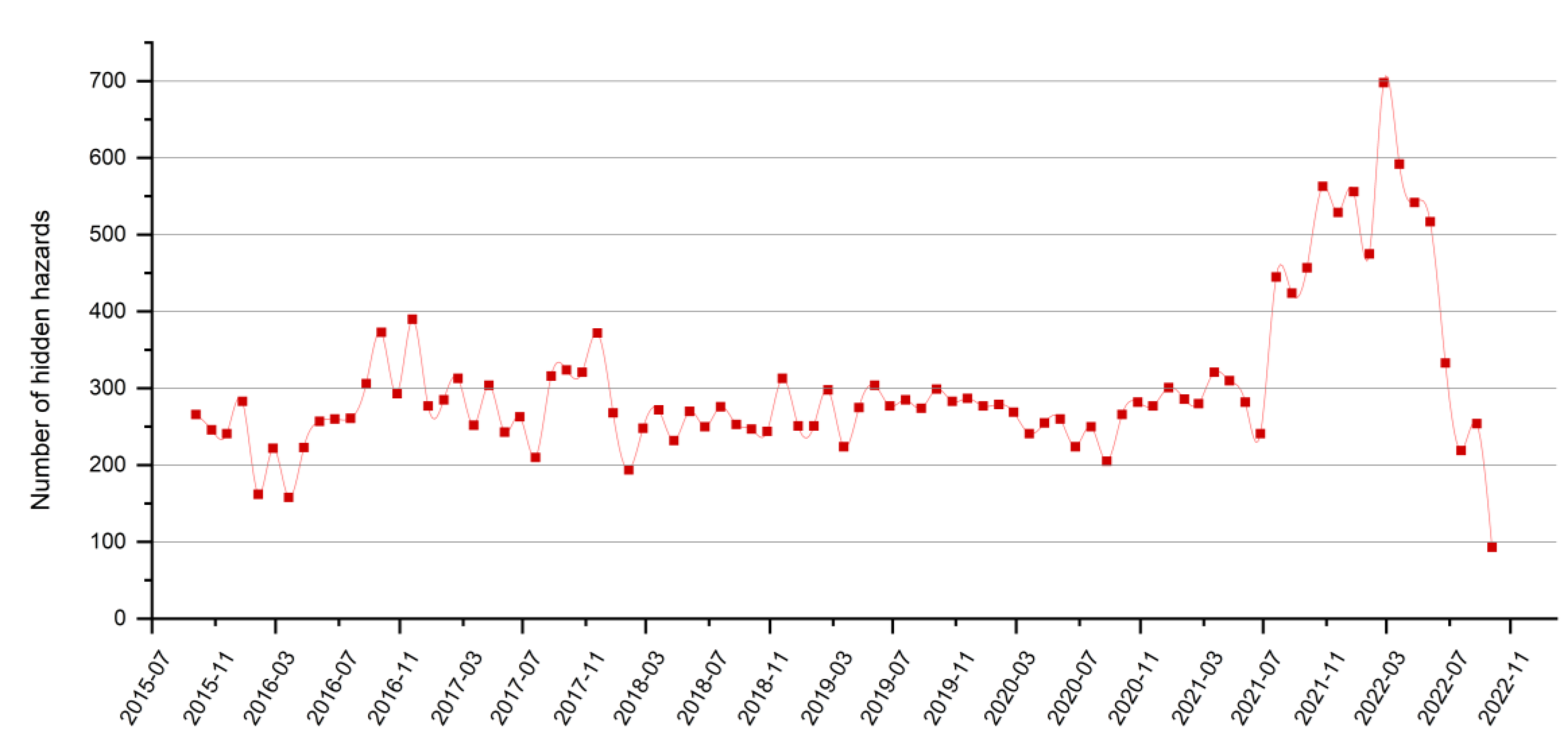1. Introduction
The mining industry is the pillar industry of the national economy, but it is also one of the industries with frequent accidents and the highest rate of employee casualties; therefore, its safety production has long been a wide concern. Due to the complex and ever-changing labor conditions and working environment, as well as the discontinuous main production operations and wide production coverage, underground metal mines have extremely complex production organizations, which greatly increases the difficulty of safety risk management.
The development of modern information technology has created conditions for the transformation of mining safety risk management methods. Many mines have established corresponding control systems according to their own safety management needs. In terms of the construction of a safety monitoring system, Zhang [
1] built a mining safety monitoring system based on GIS technology, which realized the full-process monitoring and supervision of mining safety production. Wang [
2] and Chen [
3] built sensor-based mining safety remote monitoring systems, which proposed a new solution for mine safety risk management. Wu et al. [
4] constructed a mobile intelligent mining early warning platform using technologies such as the Internet of Things, mobile Internet, and intelligent control theory, which effectively solved the bottleneck problem of mine information management and safety early warning. For the aspect of safety management business system construction, some scholars have also conducted research, mainly focusing on safety training management [
5], occupational health management [
6], and emergency rescue management [
7].
With the long-term promotion of the mine safety risk management business and the completion and implementation of mine safety monitoring and control systems based on multiple types of sensors, mining enterprises have accumulated a large amount of safety production data. As a valuable asset accumulated by mines in the process of dealing with actual safety risks, the use of intelligent analysis tools to fully explore the information of the laws implied in safety production data and realize the in-depth utilization of safety data assets has become an effective means to strengthen the pertinence and scientificity of safety management and control. Current research on the in-depth utilization of safety production data mainly focuses on safety status assessment and prediction [
8,
9,
10,
11,
12,
13,
14], safety risk identification and analysis [
15,
16,
17,
18], and safety risk pre-control [
19,
20,
21]. Wu et al. [
22] established a mine safety supervision capability evaluation index system consisting of a target layer, a criterion layer, and a sub-criterion layer, and identified effective measures that could improve the efficiency of safety supervision by determining the weights of each index and combining the accident causation 2–4 model. Verma et al. [
23] used an ARIMA model to predict the trend of safety events based on 45 months of incident data from a steel plant and refined the analytical model using the Apriori algorithm. The resulting rules mined can help the plant management department formulate safety management policies. Guo et al. [
24] used big data analysis models such as topic mining and association rule mining to explore the internal connections between different safety risks and analyzed the distribution patterns of risks in multiple dimensions such as time and space.
Research on the collection and application of mine safety information and the analysis, identification, and classification of safety risks has been more in-depth at present. However, there are still problems, such as data sources limited to a single business system, which cannot realize personalized, intelligent, automatic evaluation, and dynamic updates of safety risk identification and early warning based on the full volume of mine safety production information. This is due to the lack of overall planning of the mine’s safety data management system, resulting in incomplete collection of safety data, which seriously restricts the effectiveness of safety risk data analysis and decision-making. Therefore, studying the comprehensive collection and governance of mine safety production data and realizing the standardized storage of production data are the primary conditions for realizing the in-depth utilization of safety product information. There have been studies on the collection and governance of heterogeneous data from multiple sources [
25,
26,
27], but they have mainly focused on the fields of finance [
28], materials [
29], and agriculture [
30]. There are fewer studies related to the collection and governance of safety risk management data from scattered sources and diverse formats in underground metal mines. In this situation, utilizing information and intelligent technology to comprehensively sort out safety risk management businesses and to reorganize and utilize safety risk data has become an important way to innovate mining safety management models.
In view of the above problems, starting from the needs of big data analysis of mine safety risks, this paper constructed a big data governance and fusion framework by sorting out the data resources accumulated by the existing safety management system, realizing the collection, standardization, and normalization of multi-source heterogeneous safety information of mines, and formed the safety data assets of underground metal mines. With the help of big data analysis technology, an intelligent analysis and early warning model of mine safety risks was realized, which provides support for safety risk identification and prevention, hazard source classification, control strategy formulation, and safety emergency disposal. Through the integrated display of business intelligence visualization platforms, the physical application of safety risk big data analysis was achieved, and the scientificity and effectiveness of the system were ultimately verified through a mining instance application.
2. Analysis of System Business Requirements
Since the beginning of the new century, new equipment and information technology have developed rapidly and have been widely applied in the field of mining production, leading to profound changes in production processes and management modes. The operation of production systems has become complex and changeable. The subjects that generate safety risks have become more decentralized and diversified and have shown significant dynamic change characteristics. This has resulted in an increasingly prominent problem of traditional safety management methods being incompatible and inconsistent with intelligent production methods. With the continuous promotion of intelligent mining, the management of safety risks in underground metal mines faces the following new demands:
- (1)
Integration and governance of safety risk information:
The continuous promotion of information technology in mining safety management has accumulated a large amount of information such as safety monitoring and control, safety hazard investigation and rectification, and personnel safety records in mines, which are massive, growing rapidly, and diverse in types. However, the particularity and complexity of mining safety production management results in numerous dimensions and huge content of corresponding mining safety information, which limits its in-depth utilization. Therefore, it is necessary to build an efficient big data acquisition and integration governance system to achieve the standardization and storage of safety risk information.
- (2)
In-depth utilization of mining safety risk data:
Making safety management proactive, purposeful, and focused has been a long-standing challenge for mine safety managers. The development of technologies such as big data analysis and artificial intelligence has brought new avenues for the deep utilization of safety risk data and the in-depth exploration of safety risk patterns. By utilizing intelligent means, providing scientific theoretical, technical support, and decision-making model reference for the comprehensive transformation of safety management from extensive to accurate, from post-event to prevention, and from local to overall has been considered an effective way to achieve the intrinsic safety of mines.
- (3)
Interpretation and integrated visualization of safety issues:
Traditional safety data analysis and display is mainly based on text description and simple chart display. Not only is the form of data display single, but also the dimensions of data presentation are not comprehensive and in-depth enough, which is not conducive to the interpretation and discovery of safety problems by managers. For this reason, mine safety data visualization needs to fully combine the characteristics of the analysis results and select the visualization graphics that can present the internal mode, association, and structure of the data, so that complex safety risk information can be easily understood and applied.
3. System Design
3.1. Function System Design
In view of the new requirements of safety risk management and control under the background of intelligent mines, the main functions of the intelligent analysis and decision-making system for safety risks in underground metal mines were designed using system engineering theory, which mainly includes the modules of safety data collection and governance, big data analysis models and algorithm libraries, safety information visualization display, and system management and maintenance. The specific functions are shown in
Figure 1.
- (1)
Data Collection and Governance: The system has full process management functions for multi-source safety risk data collection and governance, can extract mining safety monitoring system and business system data through data interfaces, and achieves the standardized governance of multi-source data based on data specifications.
- (2)
Big Data Analysis Model: The system can use encapsulated big data analysis models to analyze the governed safety risk data, so as to complete the intelligent identification of hazard sources and in-depth analysis of the distribution, evolution, and correlation of safety risks.
- (3)
Data Visualization Display: The system has built-in rich data visualization tools, which support visually integrated query and display of safety risk big data analysis results and standardized storage of multi-dimensional safety risk information, as well as data penetration and linkage analysis functions.
- (4)
System Management and Maintenance: This module is used for the maintenance of the overall system framework, and all settings related to basic information settings and parameter configuration are completed in this module, mainly including the maintenance and management of users, roles, permissions, menus, and logs.
3.2. System Architecture Design
According to the process of data to information, model to service, and management to decision-making, the overall architecture of the safety risk intelligent analysis and decision-making system is formed, including the infrastructure layer, data resource layer, data governance layer, decision analysis layer, and comprehensive display layer, as shown in
Figure 2.
- (1)
Infrastructure layer: as the underlying technology and hardware support of the platform, it mainly includes supporting facilities for data collection and governance, basic technologies, and network guarantees for system operation.
- (2)
Data resource layer: the main data sources for intelligent analysis of mine safety risks, including safety risk data formed in the process of safety risk management business and safety monitoring.
- (3)
Data governance layer: with the support of data governance facilities and technologies, it provides standardized data resources for the system and forms a core data resource library for multi-dimensional data integration.
- (4)
Decision analysis layer: using big data analysis and other technical means, comprehensively analyze the distribution, correlation, and evolution of safety risks and provide decision-making assistance for mine safety production management.
- (5)
Comprehensive display layer: by utilizing various information display terminals, multi-scenario security risk analysis and display can be achieved to meet the decision-making needs of security management personnel at all levels.
3.3. Design of Data Interaction Methods
The intelligent mining safety risk analysis and decision-making system interacts with other existing systems in the mine, including safety monitoring, safety business, human resources, material and equipment management systems, etc. At the same time, it is necessary to sort out the internal data flow mode of the system to create conditions for the implementation of the system. The specific information interaction process is shown in
Figure 3.
- (1)
The mine safety monitoring system mainly provides personnel location early warning information, environmental monitoring information, equipment monitoring information, etc., which are used for real-time analysis of the mine safety operation status.
- (2)
The safety risk business management system mainly provides hidden danger investigation data, equipment maintenance, repair data, occupational safety data, etc., while the data center can provide data support for the business system.
- (3)
Human resources, equipment, material systems, etc. provide corresponding archival information as master data throughout the entire intelligent safety risk analysis and decision-making system.
- (4)
The Safety Risk Data Center provides standardized datasets for big data analysis. After the data are processed by big data analysis models, the mine safety analysis results are output, and finally integrated and displayed through a visual interface.
4. Implementation of System Core Functions
4.1. Collection and Governance of Multi-Source Safety Risk Information
The construction of the system requires the sharing of data from existing human resources, equipment, materials, and other systems in the mine. To avoid duplicate construction, it is necessary to design a unified data collection interface and data conversion method to achieve standardized services for basic data. At the same time, to achieve in-depth utilization of mine safety monitoring data and business management data, it is first necessary to achieve the collection, governance, and storage of a large amount of multi-source and heterogeneous safety data in mines, providing a dataset with a certain degree of integration and expressiveness for subsequent big data analysis.
- (1)
Data Collection
Based on the different storage characteristics of safety business data and safety monitoring data, different data integration methods were designed. By building standardized data interfaces, cross-device integration, cross-application integration, and cross-network integration of safety risk data were realized.
- (2)
Data Governance
Determining the perspective of data observation and the path of knowledge mining are the premise and foundation of big data analysis, which requires the dimensionalization and standardization of a large amount of risk information. Therefore, after achieving the integration and collection of safety risk data, the entire process of data governance needs to be carried out. The processing of the collected safety production information mainly involves data cleaning, reduction, and conversion.
- (1)
Data cleaning: Used to delete duplicate information and correct existing errors, mainly including consistency checks, missing value handling, error value handling, etc.
- (2)
Data reduction: Data reduction refers to minimizing the amount of data while maintaining the integrity of the original data as much as possible, mainly using methods such as feature induction and sample reduction.
- (3)
Data conversion: Data transformation is the process of redesigning and organizing data representation. The main methods include standardization, discretization, and semantic transformation.
After data governance, safety risk data form a five-layer hierarchical structure of subject domain grouping, subject domain, business object, logical entity, and attributes. Taking security risk management data as an example, the hierarchical structure after governance is shown in
Figure 4.
- (3)
Data Storage and Services
After completing the collection and governance of safety risk data, it is necessary to complete the storage of large-scale data after governance to form highly aggregated, standardized, and integrated data assets, as shown in
Table 1, and establish a standardized data publishing interface to provide data support for data analysis and knowledge mining.
4.2. Intelligent Analysis Model for Safety Risk
By constructing safety risk big data analysis models and algorithms, researching and investigating new approaches to the scientific management of mine safety risks, and fully exploring the potential value of mine safety production data, the overall implementation process of safety risk intelligence analysis and early warning is performed, as shown in
Figure 5. Based on the standardized safety business data and monitoring data, the existing big data analysis models and algorithms were modularized, encapsulated, and materialized to rapidly respond to data analysis requirements. Finally, the integrated display of risk information was achieved through business intelligence tools and data visualization algorithms.
- (1)
Quantitative Processing of Text-based Data
After standardized processing, such as data cleaning and governance, safety monitoring data can be analyzed and mined based on data mining algorithms. However, a large number of text data represented by safety hazard investigation data in the process of mine safety management have great differences due to the influence of the language habits of inspectors, which brings difficulty to safety knowledge mining. It needs to be standardized and quantified first before subsequent mining analysis can be carried out. Through the construction of a standard semantic thesaurus suitable for safety risk data in underground metal mines, the essential separation of safety risk text data is realized, and a safety risk multi-dimensional dataset is formed. Finally, the quantitative processing of text safety risk data is completed through word vector mapping.
- (2)
Materialization of analytical models
The safety risk identification, hazard source grading, safety prevention and control strategies, and safety emergency response were realized based on big data analysis such as safety risk theme clustering, intelligent identification of safety risks, mining of safety risk association laws, generation and distribution laws of safety risks, evolution analysis and early warning of safety risks facing different dimensions. All of the data analysis models were encapsulated as scripts. The models and algorithms for the data analysis application are shown in
Table 2.
- (3)
Data Visualization Based on Business Intelligence
The visualization system was built through business intelligence analysis tools. By connecting with the data center, massive amounts of data can be extracted and combined. Finally, through the application of visualization technology, various analysis charts, and models formed by the physical application of safety risk big data analysis were integrated and displayed. The system supports data penetration and linkage functions for key data and dynamically monitors the status of mine safety operations. The integrated visualization architecture of the safety risk information is shown in
Figure 6.
5. Case Study and Results
5.1. System Instance Verification
This article takes a large underground gold mine in China as a pilot unit, which has successively built a personnel positioning system, a monitoring and control system, and an integrated safety production management system, which provides a basic guarantee for mine production safety.
Figure 7 and
Figure 8 illustrate the business management interface for hierarchical safety risk control. The long-term application of the relevant information system has accumulated a large amount of safety risk management data for the mine, which provides data support for the construction of the system described in this paper.
Based on the system design and construction of the key functional modules of the system, the collection and governance of safety risk data were completed on the basis of the construction of a data center. Distributed, diverse, and heterogeneous safety risk information was organically integrated, and the entity and systematization of big data analysis functions were achieved. The main functional interface for intelligent analysis and decision-making of security risks is shown in
Figure 9.
The typical application scenarios of the system are as follows:
- (1)
Intelligent identification of hazard sources. The big data analysis method is used to intelligently identify the main hazard sources in the production process of mines and provide a basis for mines to find the content and area of major risk points.
- (2)
Analysis of safety risk trends. The trend chart is used to analyze the changing trend of safety risks in different dimensions such as time, space, and category.
- (3)
Mining of safety risk association rules. Hierarchical edge binding and force-oriented layouts were used to characterize the correlation law and co-association law between major safety risks in mines.
- (4)
Intelligent early warning of safety accidents. The accident tree is used to visualize the generation path of mine safety accidents, and to a certain extent, the early warning of safety accidents is realized.
5.2. Analysis of System Application Effect
Aiming at the highly concerned issue of intelligent analysis and decision-making of mining safety risks, with the goal of integration, systematization, and intelligence, an intelligent analysis and decision-making system of safety risks has been developed using big data analysis and business intelligence technology. The construction and application of the system have greatly strengthened the safety management level of the mine, making the production process of the mine smoother and more orderly, avoiding the instability of production processes caused by the evolution and expansion of safety risks, and effectively improving production efficiency. Big data analysis makes all aspects of safety management clear and transparent, enabling the timely detection, tracing, and handling of various risks, effectively eliminating hidden hazards of accidents and reducing the occurrence of casualties. The trend in the frequency of hidden hazards in the service of mine safety hazard investigation is shown in
Figure 10.
As shown in the figure, before the application of the safety risk intelligence analysis and decision-making system, the number of mine safety hazards was in a high-fluctuation stage. After the system was put into application in July 2021, the number of hazards increased sharply within a certain period, which is due to big data analysis making the hazard identification work more targeted, assisting the mine to focus on identifying certain high-risk hazards, and leading to an increase in the number of hazards. From March 2022, the number of hidden hazards began to decline rapidly. As of August 2022, after targeted safety training and safety risk governance, the number of hidden hazards has been significantly lower than the average level before system application, and the safety level of the mine has been effectively improved.
6. Conclusions
Safety production is a highly concerned theme in mining operations, and it is also one of the important contents of intelligent mine construction. The construction of an intelligent safety risk analysis and decision-making system is an active exploration of new ideas and systems for safety management, making mine organization and management more complete, safety management more efficient, and data utilization more in-depth, forming a new model of safety risk management suitable for modern mines. The following conclusions were obtained from the research in this paper:
- (1)
Based on safety production data governance, the information related to mine safety has been integrated, and the transformation from massive safety data records to large-scale and standardized data assets has been completed. By introducing big data analysis technology and mining the value of safety data assets, the safety risk management of mines can move from the original transaction processing to the stage of big data intelligence analysis.
- (2)
By utilizing business intelligence and visualization technology, the systematic and multi-dimensional reflection of the safety status of a mine can form clear and intuitive safety production information to assist decision-making, which can greatly improve the efficiency of safety control.
- (3)
The application of the system has significant effects on scientific and in-depth safety analysis, clear and intuitive display of safety status, and effective and appropriate safety measures, which can effectively eliminate the risk of mine safety accidents and improve the overall safety level of the mine.
However, the current application of safety monitoring data in the system is limited to the analysis of environmental monitoring data, and video surveillance data is not utilized. Further research will be conducted on intelligent identification of unsafe behaviors or states of personnel and equipment based on real-time image recognition to expand the means of safety risk perception. For risk data visualization, the current application of visualization methods is mainly based on two-dimensional graphics. In the future, the safety risk integration visualization mode based on a three-dimensional refined model will be studied to make the risk data display more intuitive and comprehensive.
Author Contributions
Methodology, G.L.; Software, J.H.; Validation, X.Q.; Resources, X.Z. and Y.L.; Data curation, J.H. and X.Q.; Writing—original draft, X.Q.; Writing—review and editing, G.L. and J.H.; Visualization, X.Q.; Supervision, G.L. All authors have read and agreed to the published version of the manuscript.
Funding
This research was funded by the National Natural Science Foundation of China (No. 52074022) and National Key R&D Program of China (No. 2022YFC2903905).
Institutional Review Board Statement
Not applicable.
Informed Consent Statement
Not applicable.
Data Availability Statement
Not applicable.
Acknowledgments
Some Python libraries such as sciKit-Learn, mlxtend, statsModels, scipy, and Genism were used in this work to build data analysis models.
Conflicts of Interest
The authors declare no conflict of interest.
References
- Zhang, J. Design and Implementation of Coal Mine Safety Monitoring System Based on GIS. Wirel. Commun. Mob. Comput. 2022, 2022, 4771395. [Google Scholar] [CrossRef]
- Wang, X. Development of digital technologies for the systems of remote mining safety monitoring. In Proceedings of the 2nd International Conference on Economy, Management and Entrepreneurship (ICOEME 2019), Voronezh, Russia, 14–15 May 2019; Volume 85, pp. 252–255. [Google Scholar]
- Chen, W.; Wang, X. Coal mine safety intelligent monitoring based on wireless sensor network. IEEE Sens. J. 2020, 21, 25465–25471. [Google Scholar] [CrossRef]
- Chao, W.; Wu, Y.; Zhu, C.; Zhang, C.; Song, Q. Research on mobile intelligent mine platform based on risk control. Earth Environ. Sci. 2020, 601, 012005. [Google Scholar]
- Liu, H.Y.; Guan, H.H.; Zhao, Z.Y. Study on Active Safety Training Methods in Coal Industry. Adv. Mater. Res. 2013, 726–731, 921–925. [Google Scholar] [CrossRef]
- Zhou, L.; Cao, Q.; Yu, K.; Wang, L.; Wang, H. Research on occupational safety, health management and risk control technology in coal mines. Int. J. Environ. Res. Public Health 2018, 15, 868. [Google Scholar] [CrossRef]
- Qi, L.X.; Yang, X. Research on a Coal Mine Emergency Command Information System. Appl. Mech. Mater. 2011, 58–60, 2564–2569. [Google Scholar] [CrossRef]
- Yari, M.; Bagherpour, R.; Khoshouei, M.; Pedram, H. Investigating a comprehensive model for evaluating occupational and environmental risks of dimensional stone mining. Rud.-Geol.-Naft. Zb. 2020, 35, 101–109. [Google Scholar] [CrossRef]
- Ezzeddin, B.; Samuel, Y. Assessment of workplace accident risks in underground collieries by integrating a multigoal cause-and-effect analysis method with MCDM sensitivity analysis. Stoch. Environ. Res. Risk-Assessment 2018, 32, 3317–3332. [Google Scholar]
- Mulumba, D.M.; Liu, J.; Hao, J.; Zheng, Y.; Liu, H. Application of an Optimized PSO-BP Neural Network to the Assessment and Prediction of Underground Coal Mine Safety Risk Factors. Appl. Sci. 2023, 13, 5317. [Google Scholar] [CrossRef]
- Yang, W.; He, S. Coal mine safety management index system and environmental risk model based on sustainable operation. Sustain. Energy Technol. Assess. 2022, 53, 102721. [Google Scholar] [CrossRef]
- Dong, G.; Wei, W.; Xia, X.; Woźniak, M.; Damaševičius, R. Safety Risk Assessment of a Pb-Zn Mine Based on Fuzzy-Grey Correlation Analysis. Electronics 2020, 9, 130. [Google Scholar] [CrossRef]
- Bai, G.; Xu, T. Coal Mine Safety Evaluation Based on Machine Learning: A BP Neural Network Model. Comput. Intell. Neurosci. 2022, 2022, 5233845. [Google Scholar] [CrossRef] [PubMed]
- Rahul, K.; Virani Bhada, S. Integrated System Design and Safety Framework for Model-Based Safety Assessment. IEEE Access 2022, 10, 79311–79334. [Google Scholar]
- Cheng, L.; Guo, H.; Lin, H. Evolutionary model of coal mine safety system based on multi-agent modeling. Process Saf. Environ. Prot. 2021, 147, 1193–1200. [Google Scholar] [CrossRef]
- Gao, R.; Zhou, K.; Yang, C.; Zhu, K. An Underground Mine Risk Identification Model and Safety Management Method Based on Explanation Graph-Probabilistic Multi-Plan Analysis (EG-PMPA). IEEE Access 2020, 8, 223214–223233. [Google Scholar] [CrossRef]
- Hamad, A.; Sakdirat, K.; Min, A. A Deep Learning Approach Towards Railway Safety Risk Assessment. IEEE Access 2020, 8, 102811–102832. [Google Scholar]
- Yang, X.; Xing, Q.; Tian, K.; Liu, C.; Yang, J. Using the ISM-ANP-SD combination model to explore the mechanism and intervention strategies of influencing factors of coal mine safety system. Front. Public Health 2022, 10, 1053298. [Google Scholar] [CrossRef]
- Lu, J.; Liu, W.; Yu, K.; Zhou, L. The Dynamic Evolution Law of Coal Mine Workers’ Behavior Risk Based on Game Theory. Sustainability 2022, 14, 4015. [Google Scholar] [CrossRef]
- Miao, D.; Lv, Y.; Yu, K.; Liu, L.; Jiang, J. Research on coal mine hidden danger analysis and risk early warning technology based on data mining in China. Process Saf. Environ. Prot. 2023, 171, 1–17. [Google Scholar] [CrossRef]
- Liu, Q.; Dou, F.; Meng, X. Building risk precontrol management systems for safety in China’s underground coal mines. Resour. Policy 2021, 74, 101631. [Google Scholar] [CrossRef]
- Wu, Y.; Chen, M.; Niu, L.; Qiu, P.; Zhou, A. A new safety supervision model for underground coal mines in China. Energy Sources Part A Recover. Util. Environ. Eff. 2020, 2, 1–15. [Google Scholar] [CrossRef]
- Verma, A.; Dhalmahapatra, K.; Maiti, J. Forecasting occupational safety performance and mining text-based association rules for incident occurrences. Saf. Sci. 2023, 159, 106014. [Google Scholar] [CrossRef]
- Guo, D.; Li, G.; Hu, N.; Hou, J. Big data analysis and visualization of potential hazardous risks of the mine based on text mining. Chin. J. Eng. 2022, 44, 328–338. [Google Scholar]
- Hu, R.; Zhao, H.-M.; Wu, Y. The methods of big data fusion and semantic collision detection in Internet of Thing. Clust. Comput. 2018, 22, 8007–8015. [Google Scholar] [CrossRef]
- Zhang, T.; Li, H.; Jin, T.; Hu, F. Big Data Fusion Method Based on Internet of Things Collection. Comput. Intell. Neurosci. 2022, 2022, 1835309. [Google Scholar] [CrossRef]
- Ma, N.; Fu, W. Feature fusion analysis of big cognitive data. Multimed. Tools Appl. 2020, 79, 5461–5475. [Google Scholar]
- Yue, H.; Liao, H.; Li, D.; Chen, L. Enterprise Financial Risk Management Using Information Fusion Technology and Big Data Mining. Wirel. Commun. Mob. Comput. 2021, 2021, 3835652. [Google Scholar] [CrossRef]
- Zhou, J.; Hong, X.; Jin, P. Information Fusion for Multi-Source Material Data: Progress and Challenges. Appl. Sci. 2019, 9, 3473. [Google Scholar] [CrossRef]
- Zhang, F.; Zhang, Y. A big data mining and blockchain-enabled security approach for agricultural based on Internet of Things. Wirel. Commun. Mob. Comput. 2020, 2020, 6612972. [Google Scholar] [CrossRef]
| Disclaimer/Publisher’s Note: The statements, opinions and data contained in all publications are solely those of the individual author(s) and contributor(s) and not of MDPI and/or the editor(s). MDPI and/or the editor(s) disclaim responsibility for any injury to people or property resulting from any ideas, methods, instructions or products referred to in the content. |
© 2023 by the authors. Licensee MDPI, Basel, Switzerland. This article is an open access article distributed under the terms and conditions of the Creative Commons Attribution (CC BY) license (https://creativecommons.org/licenses/by/4.0/).
